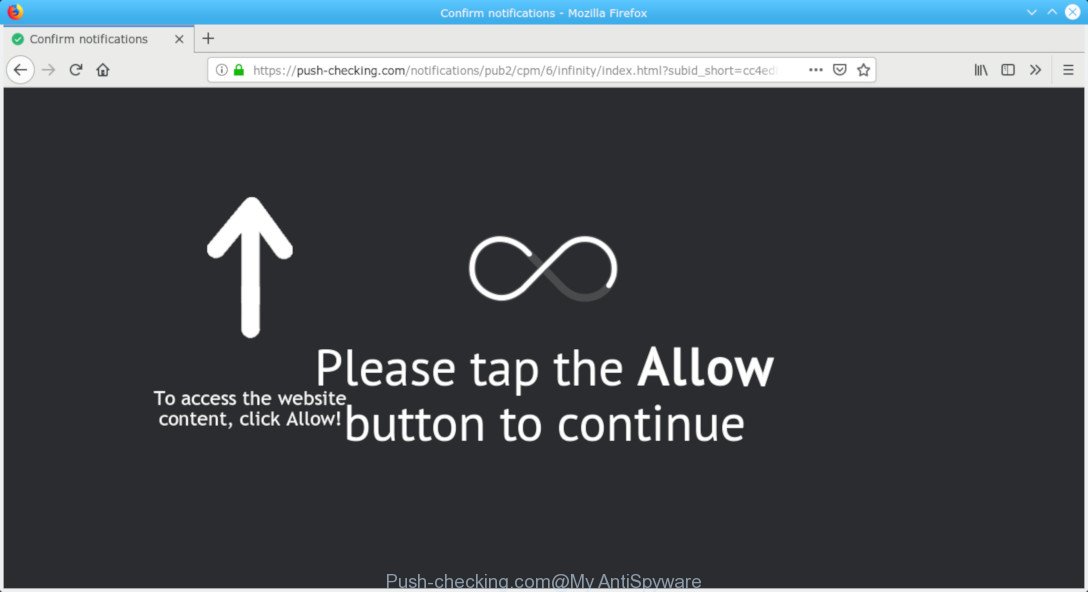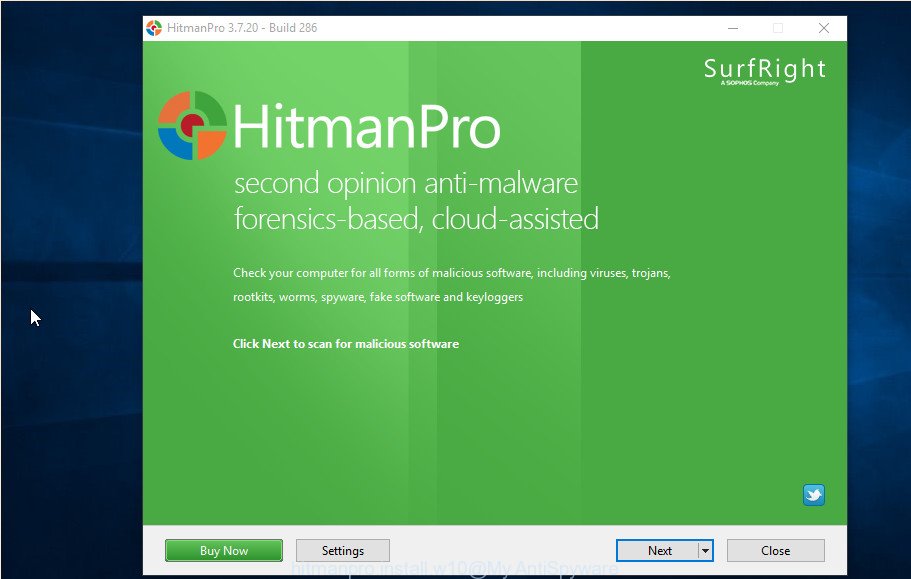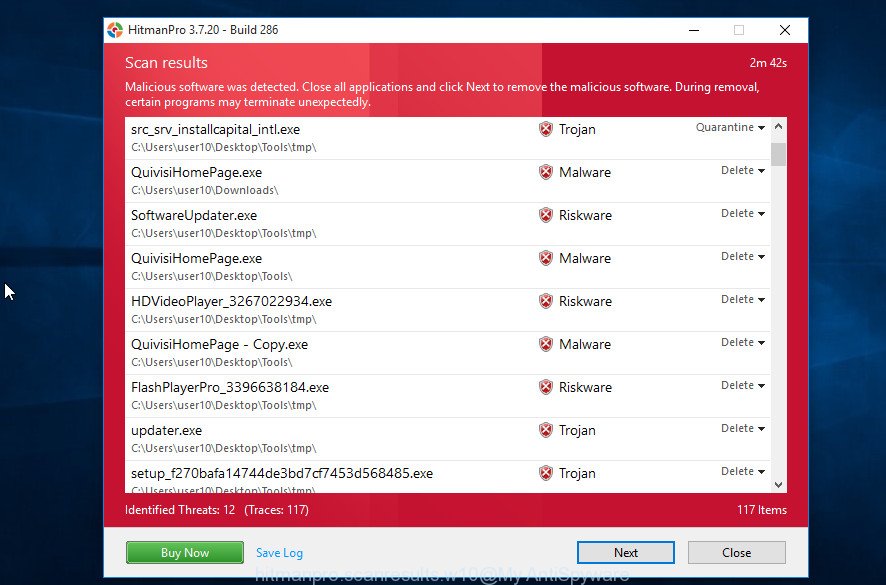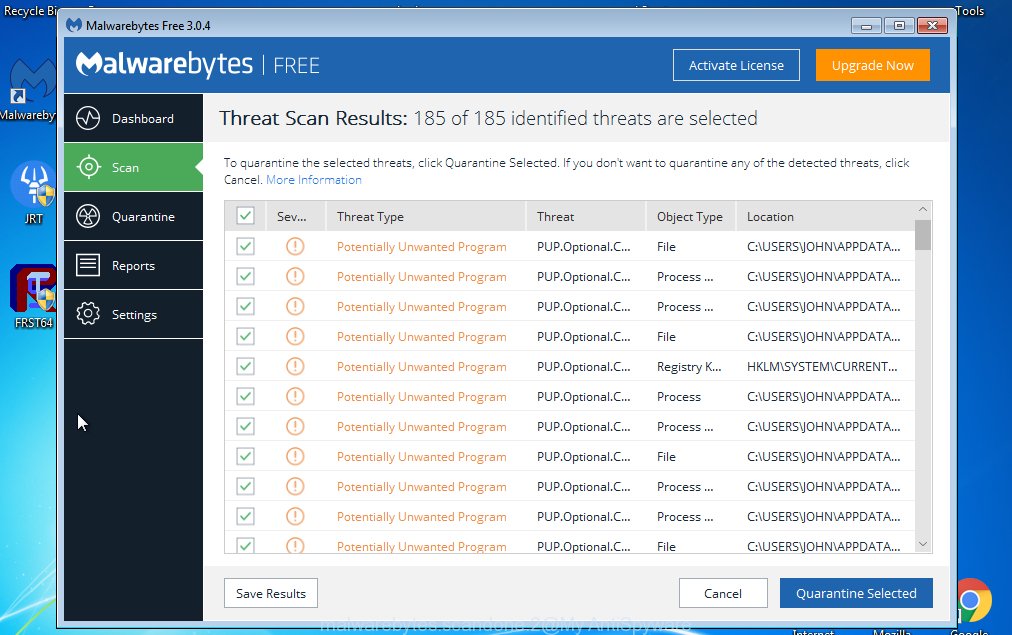Did you get undesired popups, ads or notifications from Push-checking.com and wonder where it came from? It is possible that your PC has become a victim of the malicious software from the adware (also known as ‘ad-supported’ software) category. Here’s below how the Push-checking.com pop up ads looked like when I got it on my system.

Push-checking.com pop-up
Adware is an unwanted software which is going to open you lots of pop up ads and deals. Of course, it’s not a malicious software or virus in the “general meaning” of this word. It will not delete or damage your files, but it can alter some PC’s settings or download and install other harmful software. So, you’d better to get rid of adware software using the steps below.
Adware software can also include other forms of malware. It can steal user data from the personal computer and pass it on to third parties. Adware has also been the basis for hacking to gain access to the PC.
By following few simple steps below it is easy to detect and get rid of adware from Microsoft Edge, Internet Explorer, Google Chrome and Firefox and your system. Learn how to get rid of Push-checking.com pop up advertisements and harmful software, as well as how to run a full computer virus scan.
How to remove Push-checking.com pop-up ads, notifications from Chrome, Firefox, IE, Edge
As with deleting adware software, malicious software or PUPs, there are few steps you may do. We suggest trying them all. If you do only one part of the tutorial, then it should be use malware removal utility, because it should get rid of adware and stop any further infection. But to completely delete Push-checking.com popup advertisements you will have to at least reset your web-browser settings like default search engine, home page and new tab to default state, disinfect PC system’s web browsers shortcuts, delete all unwanted and suspicious software, and remove adware software with malicious software removal utilities. Certain of the steps below will require you to close this web-site. So, please read the steps carefully, after that bookmark or print it for later reference.
To remove Push-checking.com pop-ups, perform the steps below:
- How to remove Push-checking.com redirect without any software
- How to remove Push-checking.com advertisements with free applications
- Use AdBlocker to block Push-checking.com and stay safe online
- How did Push-checking.com popups get on your PC system
- Finish words
How to remove Push-checking.com redirect without any software
Most common adware may be uninstalled without any antivirus programs. The manual adware removal is steps that will teach you how to get rid of the Push-checking.com redirect.
Delete adware through the MS Windows Control Panel
The main cause of Push-checking.com ads could be potentially unwanted apps, adware software or other undesired applications that you may have unintentionally installed on the PC. You need to identify and uninstall all dubious software.
Windows 8, 8.1, 10
First, click the Windows button
Windows XP, Vista, 7
First, click “Start” and select “Control Panel”.
It will display the Windows Control Panel as shown in the following example.

Next, click “Uninstall a program” ![]()
It will display a list of all software installed on your computer. Scroll through the all list, and remove any suspicious and unknown apps. To quickly find the latest installed applications, we recommend sort apps by date in the Control panel.
Remove Push-checking.com pop-ups from Chrome
Reset Google Chrome settings to delete Push-checking.com pop-ups. If you are still experiencing issues with Push-checking.com popups, you need to reset Chrome browser to its default values. This step needs to be performed only if adware software has not been removed by the previous steps.
First start the Chrome. Next, press the button in the form of three horizontal dots (![]() ).
).
It will show the Google Chrome menu. Select More Tools, then press Extensions. Carefully browse through the list of installed add-ons. If the list has the add-on signed with “Installed by enterprise policy” or “Installed by your administrator”, then complete the following tutorial: Remove Google Chrome extensions installed by enterprise policy.
Open the Chrome menu once again. Further, press the option called “Settings”.

The web-browser will open the settings screen. Another method to open the Chrome’s settings – type chrome://settings in the web browser adress bar and press Enter
Scroll down to the bottom of the page and press the “Advanced” link. Now scroll down until the “Reset” section is visible, as shown in the figure below and click the “Reset settings to their original defaults” button.

The Chrome will display the confirmation dialog box as displayed on the image below.

You need to confirm your action, press the “Reset” button. The browser will start the task of cleaning. After it’s done, the web-browser’s settings including startpage, search engine and newtab back to the values which have been when the Chrome was first installed on your PC.
Delete Push-checking.com advertisements from Firefox
Resetting Mozilla Firefox internet browser will reset all the settings to their original settings and will remove Push-checking.com pop up ads, malicious add-ons and extensions. However, your saved bookmarks and passwords will not be lost. This will not affect your history, passwords, bookmarks, and other saved data.
Click the Menu button (looks like three horizontal lines), and press the blue Help icon located at the bottom of the drop down menu like below.

A small menu will appear, click the “Troubleshooting Information”. On this page, click “Refresh Firefox” button like below.

Follow the onscreen procedure to restore your Mozilla Firefox browser settings to their original settings.
Remove Push-checking.com pop up ads from IE
The Internet Explorer reset is great if your internet browser is hijacked or you have unwanted addo-ons or toolbars on your web browser, that installed by an malicious software.
First, start the Internet Explorer, click ![]() ) button. Next, click “Internet Options” as shown in the following example.
) button. Next, click “Internet Options” as shown in the following example.

In the “Internet Options” screen select the Advanced tab. Next, click Reset button. The Microsoft Internet Explorer will open the Reset Internet Explorer settings prompt. Select the “Delete personal settings” check box and click Reset button.

You will now need to restart your PC system for the changes to take effect. It will get rid of adware responsible for Push-checking.com redirect, disable malicious and ad-supported web-browser’s extensions and restore the Microsoft Internet Explorer’s settings such as startpage, search engine and newtab to default state.
How to remove Push-checking.com advertisements with free applications
It is not enough to get rid of Push-checking.com redirect from your internet browser by following the manual steps above to solve all problems. Some the adware related files may remain on your machine and they will recover the adware even after you get rid of it. For that reason we recommend to use free antimalware utility like Zemana Anti-Malware, MalwareBytes Free and Hitman Pro. Either of those programs should can be used to scan for and remove adware that causes a large number of unwanted Push-checking.com advertisements.
Scan and clean your web browser of Push-checking.com pop up advertisements with Zemana
Zemana Anti-Malware (ZAM) is an amazing utility to remove Push-checking.com pop up advertisements from the Mozilla Firefox, Internet Explorer, Edge and Chrome. It also deletes malware and adware software from your computer. It improves your system’s performance by removing potentially unwanted software.
Now you can install and use Zemana AntiMalware to remove Push-checking.com popup advertisements from your web browser by following the steps below:
Visit the following page to download Zemana Anti Malware installer called Zemana.AntiMalware.Setup on your PC system. Save it on your MS Windows desktop or in any other place.
164782 downloads
Author: Zemana Ltd
Category: Security tools
Update: July 16, 2019
Start the setup file after it has been downloaded successfully and then follow the prompts to setup this tool on your system.

During installation you can change certain settings, but we suggest you do not make any changes to default settings.
When setup is finished, this malware removal utility will automatically start and update itself. You will see its main window as displayed on the screen below.

Now press the “Scan” button to perform a system scan for the adware software responsible for redirects to the Push-checking.com. This process can take some time, so please be patient. While the Zemana Anti-Malware application is checking, you can see number of objects it has identified as threat.

Once that process is complete, Zemana will show a list of all items detected by the scan. Next, you need to press “Next” button.

The Zemana Anti Malware (ZAM) will delete adware responsible for redirecting your web browser to the Push-checking.com web page and move threats to the program’s quarantine. Once the task is finished, you can be prompted to reboot your system to make the change take effect.
Scan and clean your PC of adware with Hitman Pro
Hitman Pro is a free removal utility that can be downloaded and run to remove adware software responsible for redirects to the Push-checking.com, hijackers, malware, potentially unwanted software, toolbars and other threats from your personal computer. You can run this utility to search for threats even if you have an antivirus or any other security program.
Hitman Pro can be downloaded from the following link. Save it to your Desktop so that you can access the file easily.
When the downloading process is finished, open the file location. You will see an icon like below.

Double click the Hitman Pro desktop icon. When the utility is started, you will see a screen as shown in the following example.

Further, press “Next” button to detect adware software that causes lots of annoying Push-checking.com pop ups. A scan can take anywhere from 10 to 30 minutes, depending on the number of files on your machine and the speed of your system. Once the scan get completed, a list of all threats found is prepared as shown in the following example.

All detected threats will be marked. You can remove them all by simply click “Next” button. It will show a prompt, press the “Activate free license” button.
How to automatically get rid of Push-checking.com with MalwareBytes Anti Malware (MBAM)
We recommend using the MalwareBytes Anti Malware (MBAM) which are fully clean your system of the adware. The free utility is an advanced malware removal program created by (c) Malwarebytes lab. This program uses the world’s most popular antimalware technology. It is able to help you get rid of undesired Push-checking.com popups from your web browsers, potentially unwanted applications, malicious software, hijackers, toolbars, ransomware and other security threats from your machine for free.

Download MalwareBytes Free from the following link. Save it directly to your Microsoft Windows Desktop.
327040 downloads
Author: Malwarebytes
Category: Security tools
Update: April 15, 2020
When downloading is complete, run it and follow the prompts. Once installed, the MalwareBytes Free will try to update itself and when this procedure is finished, click the “Scan Now” button . MalwareBytes utility will start scanning the whole computer to find out adware responsible for Push-checking.com popups. This task can take some time, so please be patient. While the MalwareBytes Anti-Malware (MBAM) is scanning, you can see how many objects it has identified either as being malware. Next, you need to click “Quarantine Selected” button.
The MalwareBytes Free is a free program that you can use to remove all detected folders, files, services, registry entries and so on. To learn more about this malicious software removal utility, we recommend you to read and follow the step-by-step tutorial or the video guide below.
Use AdBlocker to block Push-checking.com and stay safe online
One of the worst things is the fact that you cannot block all those annoying pages such as Push-checking.com using only built-in MS Windows capabilities. However, there is a program out that you can use to stop undesired web-browser redirects, ads and pop-ups in any modern web-browsers including Chrome, Edge, Microsoft Internet Explorer and Firefox. It is called Adguard and it works very well.
Download AdGuard on your Microsoft Windows Desktop from the following link.
26839 downloads
Version: 6.4
Author: © Adguard
Category: Security tools
Update: November 15, 2018
After downloading it, double-click the downloaded file to start it. The “Setup Wizard” window will show up on the computer screen as displayed in the following example.

Follow the prompts. AdGuard will then be installed and an icon will be placed on your desktop. A window will show up asking you to confirm that you want to see a quick guide as shown below.

Press “Skip” button to close the window and use the default settings, or press “Get Started” to see an quick guidance which will assist you get to know AdGuard better.
Each time, when you launch your system, AdGuard will start automatically and stop unwanted ads, block Push-checking.com, as well as other harmful or misleading webpages. For an overview of all the features of the application, or to change its settings you can simply double-click on the AdGuard icon, that is located on your desktop.
How did Push-checking.com popups get on your PC system
The majority of adware is bundled within free software or even paid apps which Web users can easily download online. The installation packages of such programs, most commonly, clearly show that they will install optional programs. The option is given to users to block the installation of any third-party programs. So, in order to avoid the installation of any adware: read all disclaimers and install screens very carefully, choose only Custom or Advanced install option and reject all additional apps in which you are unsure.
Finish words
Now your machine should be free of the adware that causes a lot of intrusive Push-checking.com ads. We suggest that you keep AdGuard (to help you block unwanted ads and intrusive harmful web-pages) and Zemana Anti Malware (to periodically scan your system for new adwares and other malicious software). Probably you are running an older version of Java or Adobe Flash Player. This can be a security risk, so download and install the latest version right now.
If you are still having problems while trying to remove Push-checking.com popup advertisements from the Internet Explorer, Chrome, Microsoft Edge and Firefox, then ask for help here here.




















